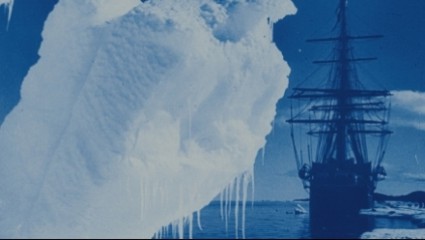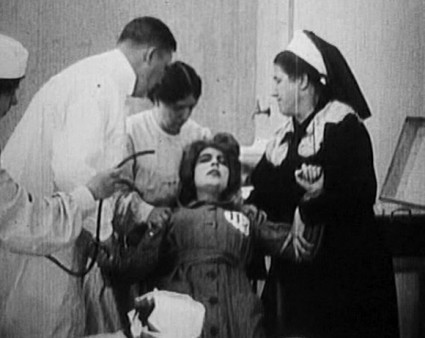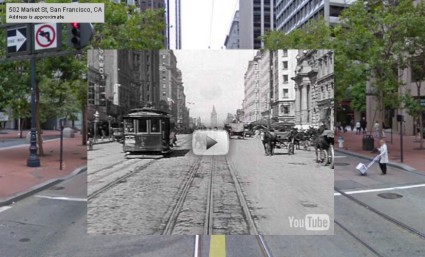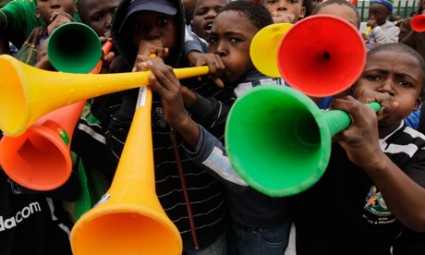Seating in the Verdi theatre, Pordenone
Let’s talk about seats. Given the amount of time that filmgoers spend sitting down to watch films, it surprising that the objects on which they rest while doing so seldom get discussed. Yet what the seating is and how it is arranged bear significantly upon our enjoyment of what is on the screen. I have sat on wooden chairs, benches, stone steps, sofas, armchairs, velvet plush seating, church pews and grass to watch silent films. At the Zancanaro theatre in Sacile, which was home to the Giornate del Cinema Muto for a few years, the seating was admirably comfortable so long as you were not much more than five-and-a-half-feet tall. For anyone of my height, you practically had to stretch yourself over three rows and to do so in an upper tier to avoid those neighbours who might quite reasonably object to such a display.
The seats under discussion here are those at the Verdi theatre in Pordenone. They are particularly comfortable seats. You could go a long way before finding better, and they could have been designed specifically to support the earnest silent film enthusiast determined to make it through three hours of the next Japanese film and being able to walk away afterwards. But then there is the matter of arrangement, and here is where the Verdi has its critics, certainly among film followers. The theatre was not designed for cinema screenings. This is most obvious in the first circle, where the central portion of seats has to be covered up because the heads of the audience would get in the way of the projector beam. But it is the sight-lines that cause the most comment. It’s not a matter that bothers me that much – I have an odd preference for looking at films from the periphery – but many want to have an optimum view of the screen wherever they choose to sit, and here the Verdi comes up short. So there is great competition for favourite seats, and festival regulars tend to occupy the same section of the theatre year after year. There is the front row crew (earnestly taking notes on every film), those who like to stretch their legs over the gap between rows midway up the stalls, those happiest to look down from the first circle (like yours truly, always seated front row, penultimate seat to the right as you face the screen), and the upper circle afficionados who look to escape the madding crowd (and hello to the cheery bunch of American students who occupied the central portion of the upper tier and whose enthusiasm for all that the festival had to offer was a delight to witness). As with any public space, the Verdi is wonderful for people watching.
Choosing your favourite seat at the Verdi
And so, after all that talk of seats, we turn to a different sort of furniture with the first film on Wednesday 6 October, Tretya Meshchanskaya (USSR 1927), known in English as Bed and Sofa. Directed by Abram Room, this gained much notoriety on its release for its frank depiction of a ménage à trois between a building worker, his bored wife, and his printer friend who is invited to stay in their Moscow apartment. Its piquant polygamous set-up, the uncritical acceptance of sexual relations outside marriage, and discussion of abortion make the film strikingly modern in tone (Jules et Jim without the savoir faire), but what really fascinates is the background detail and the attention to the minutiae of life. There is the vividness of everyday life on the Moscow streets, and the absorbing clutter of the apartment with its nick-nacks, pictures, the Stalin calendar, the curtain dividing one couple from the other man, and of course the bed and sofa. The film also allowed space for its characters to be seen thinking, engaging in the mundane. Though in the end the ménage à trois itself felt too forced, what remained with you was the sense of a film true to life as seen and felt.
Another Room film followed, Yevrei Na Zemle (Jews on the Land) (USSR 1927), a documentary on Jewish resettlements in a stark, flat, tree-less Crimea whose impact wasn’t what it might have been because the Russian titles weren’t translated, which meant we missed the reportedly light-hearted tone that they took.
I decided not to sit through Rejin (Japan 1930) (The Belle), which tipped the scales at a mere 158 minutes this time, but the print was poor and I reckoned my eyes needed a rest. After a mooch around Pordenone and conversations at the Posta, I returned in the afternoon for one of the great treats (for me) of the festival, a series of films made in Madagascar in 1898 (images from Cinémathèque française site). As someone who thought he knew film from the 1890s pretty thoroughly, news of a filmmaker from this period entirely new to the history books was thrilling in itself. Louis Tinayre was a French artist with a fascinting personal history (his parents were Communards). He made a speciality of paintings as reportage. He travelled with a French military force to Madagascar in 1895 when an uprising was being quelled and was fascinated by the country. He returned later in the year to make sketches and photographs, then again in 1898 to work on a giant panorama of the surrender of the town of Antananarivo which he exhibited at the Paris Exposition in 1900. But he didn’t just take his brush and canvas – he brought with him a Lumière Cinématographe.
How and why he obtained the camera is not known – he may have been filming scenes to aid his work on the panorama. Eighteen films have survived, having been presented to the Cinémathèque française by the filmmaker’s grandson in 2009. They are thrilling to see. Artfully composed, they show Madgascan people at work in fields, road building, going to market, going about their daily drudgery. We were shown thirteen of the eighteen, with these titles:
- Chantier de terrassement à Marorangotra [Construction of terraces at Marorangotra]
- Femmes chargeés montant et descendant une colline [Laden women going up and down a hill]
- Environs de Tananarive. Marché à Alatsinainy [Environs of Antananarivo, capital of Madagascar. Market at Alatsinainy]
- Labour de rizières par les boeufs [Ploughing in the paddy fields with oxen]
- Chantier d’empierrement à Marorangotra [Constructing a road at Marorangotra]
- Vallée [Valley]
- Forge malgache à Marorangotra [Malagasy forge at Marorangotra]
- La route d’Ambohimanara. Un jour de marché à Tananarive [The Ambohimanara road. A market day in Antananarivo]
- Labour de rizières à l’Angady [Ploughing the paddy fields at Angady]
- L’artère principale du marché à Tananarive [The main road of the market at Antananarivo]
- Jeunes garçons fabriquant des briques [Boys making clay bricks]
- Femmes transportant paniers près d’un ruisseau [Women carrying baskets near a stream]
- Hommes travaillant sur un chantier [Men working on a construction]
The people were all shown in mid-distance, with never a glimpse of a face, mere figures in a landscape (possibly supporting the panorama thesis) though always displaying movement. It was the colonial gaze par excellence. The films (in wonderfully sharp prints) were utterly compelling, just to be seeing so far back, images from a remote land being filmed for the first time, revealing landscapes and customs that were centuries old and were now captured in motion. An added bonus was that the films were accompanied by Touve Ratovondrahety, a Malagasy himself, who played piano and sang Madagascan songs. The happy sense of homeland rediscovered was palpable.
Some Pordenone regulars may mutter at these early films and hanker for the emotional journey that the feature film offers, but for others the rare chance to see the early films is why we want to be there. And so we moved to the latest installment of the Corrick Collection, a remarkable collection of films from the mid to late 1900s amassed by an Australian family of touring entertainers, and now featured over a number of Giornates. The films were introduced by festival director David Robinson, who comitted an engaging faux pas when he announced the award of some medal to the New Zealand film archive for its work in preserving the collection, an award that was diplomatically collected by the National Film and Sound Archive of Australia, which cares for the films.
The films were the usual marvellous mix. Among the stand-out titles were Le Singe Adam (France 1909), one of the most memorable films of the whole festival, in which a trained baboon imitated the actions of its trainer to an extraordinary degree that divided up the audience equally into amused and disturbed; an unidentified British film given the title The Arrested Tricar (GB c.1905) in which three boys steal a motorcar which eludes them and drives off by itself; Don Quixote (France 1904) a meticulously recreated set of scenes by Pathé including windmills that turned into giants and an impressive alternating between studio and open-air setting, all rounded off with the habitual appearance by the Pathé dancing girls; Le Sculpteur Express (France 1907), an unusual variation on the familiar ‘lightning sketch’ form of early film, here shown a sculptor making clay faces at speed; and the delightful A Winter Straw Ride (USA 1906) showing a bobsleigh journey through the show with beautiful scenic effects.
No Rastro Do Eldorado (The Silence of the Amazon), from http://www.cinemateca.gov.br
Farsangi mámor (Hungary 1921) was a three-minute fragment of an otherwise lost Hungarian feature film which was identified after stills were published on the Lost Films site. This was followed by No Rastro Do Eldorado (Brazil 1925) (The Silence of the Amazon), a return visit to the Brazilian jungle. The film was made by Silvino Santos and documented the travels of American geographer Alexander Hamilton Rice as he mapped areas of the Amazon. The film’s presentation was unusual – there were no intertitles, instead we got a somewhat breathy female live commentary taken from Rice’s own accounts of the expedition, plus a creative multi-instrumentalist who played electronica, clarinet, percussion and guitar. Rice’s words revealed a superior attitude towards the native peoples which jarred somewhat with the poetic delivery. The film was profficient at best (though the aerial views were stunning), but the print – which was supplied by the Brazilians but came via the BFI National Archive – was awful, with very poor definition. I just hope negative material survives and that someone can try and produce something a good deal sharper.
Marizza, from http://www.ilgazzettino.it
The Giornate likes to reserve the special treats for the evening shows, and pride of place went to a thirteen-minute, seventeen-second fragment of an otherwise lost feature film, Marizza, Genannt die Schmuggler-Madonna (Germany 1921-22). The reason this was so special was because the director was F.W. Murnau. The fragment survives with Italian titles in a tinted print. It would be easy to read too much into this early work of a master, and to be honest I wonder how many would detect Murnau’s hand in a tale of a bewitching gypsy loved by a customs officer and an elegant gentleman. However, even as an anonymous fragment you would have noted the adroit handling and keen eye for the right image. It looked like we were going to get Carmen in the countryside, then all too quickly it was gone and mere speculation remained.
Next up was one of the festival special musical events, with two French films accompanied by Maud Nelissen (piano), Lucio Degani (violin) and Francesco Ferrarini (‘cello). First up, shown to Yves de la Casinière’s original score, was Alberto Cavalcanti’s Rien Que Les Heures (France 1926). This venerable classic of the avant garde is an odd, beguiling work which gives an oblique view of life in Paris, mixing documentary shots with dramatised sequences. It sometimes gets labelled with the city symphonies, but it could have been set in any town or city. As the the title suggest, its real concern is time and its passing, which is the best of themes for a work of art. I’ve seen it many times and don’t think I will ever tire of it.
Next, and last for me that day, was Germaine Dulac’s La Folie des Vaillants (France 1926). I wasn’t quite sure what to make of this. It was a feminist gypsy drama of sorts (gypsies featured strongly at the Giornate), which emphasised feeling over such trivial matters as acting and plot (a Gorky story). Unfortunately acting and plot are just what audiences look out for to anchor themselves, and the film’s technical limitations distracted from the filmmaker’s symbolic intentions. Also it’s hard these days to take gypsies as the epitome of social freedom in the way that Dulac (and Murnau) did in the 1920s. So it didn’t quite work for me, but it was graced by a quite superb score from the Maud Nelissen trio – the music from the festival that I’d most want to hear again.
And then I slipped away, into the balmy night.
Pordenone diary 2010 – day one
Pordenone diary 2010 – day two
Pordenone diary 2010 – day three
Pordenone diary 2010 – day four
Pordenone diary 2010 – day six
Pordenone diary 2010 – day seven
Pordenone diary 2010 – day eight






































